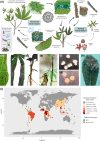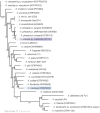Cassava diseases caused by Xanthomonas phaseoli pv. manihotis and Xanthomonas cassavae
- PMID: 34227737
- PMCID: PMC8578842
- DOI: 10.1111/mpp.13094
Cassava diseases caused by Xanthomonas phaseoli pv. manihotis and Xanthomonas cassavae
Abstract
Xanthomonas phaseoli pv. manihotis (Xpm) and X. cassavae (Xc) are two bacterial pathogens attacking cassava. Cassava bacterial blight (CBB) is a systemic disease caused by Xpm, which might have dramatic effects on plant growth and crop production. Cassava bacterial necrosis is a nonvascular disease caused by Xc with foliar symptoms similar to CBB, but its impacts on the plant vigour and the crop are limited. In this review, we describe the epidemiology and ecology of the two pathogens, the impacts and management of the diseases, and the main research achievements for each pathosystem. Because Xc data are sparse, our main focus is on Xpm and CBB.
Keywords: Xanthomonas; cassava; cassava bacterial blight; cassava bacterial necrosis; quantitative resistance.
© 2021 The Authors. Molecular Plant Pathology published by British Society for Plant Pathology and John Wiley & Sons Ltd.
Figures




References
-
- Allem, A.C. (2002) The origins and taxonomy of cassava. In: Hillocks, R.J. , Thresh, J.M. & Bellotti, A. (Eds.) Cassava: Biology, Production and Utilization. Wallingford, UK: CABI Publishing, pp. 1–16.
-
- Ambe, J.T. (1993) The effect of planting dates on three cassava diseases in Cameroon. International Journal of Pest Management, 39, 309–311.
-
- Arrieta‐Ortiz, M.L. , Rodríguez‐R, L.M. , Pérez‐Quintero, Á.L. , Poulin, L. , Díaz, A.C. , Rojas, N.A. et al. (2013) Genomic survey of pathogenicity determinants and VNTR markers in the cassava bacterial pathogen Xanthomonas axonopodis pv. manihotis strain CIO151. PLoS One, 8, e79704. - PMC - PubMed
-
- Bart, R. , Cohn, M. , Kassen, A. , McCallum, E.J. , Shybut, M. , Petriello, A. et al. (2012) High‐throughput genomic sequencing of cassava bacterial blight strains identifies conserved effectors to target for durable resistance. Proceedings of the National Academy of Sciences of the United States of America, 109, E1972–E1979. - PMC - PubMed
Publication types
MeSH terms
Supplementary concepts
LinkOut - more resources
Full Text Sources

